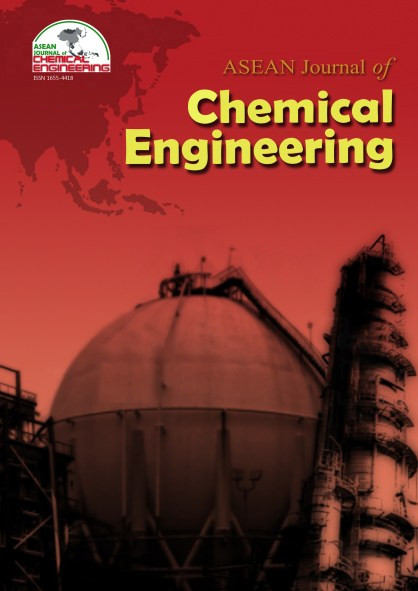Simultaneous Effect Of Temperature And Time Of Deacetylation On Physicochemical Properties Of Glucomannan
Abstract
The presence of acetyl group in the backbone of water-soluble glucomannan is responsible for its solubility. This solubility requires being modified to support glucomannan application as an encapsulant. Removing the group by deacetylation reduces the solubility. This work was aims to study simultaneous effect of temperature and time of deacetylation on glucomannan physicochemical properties. The deacetylation was conducted in ethanol using Na2CO3 at various times (2, 4, 8, 16, 24 and 28 h) and temperatures (room temperature, 40, 50, and 60°C). The deacetylated samples were subject to degree of deacetylation (DD) as well as solubility and swelling analysis in pH 1.2 and 6.8. DD was in positive correlation with deacetylation time and temperature. The solubility of the deacetylated glucomannan at both pHs decreased along with the deacetylation time. A reverse trend was found for swelling determination at both pHs. Increasing deacetylation temperature showed a positive impact in swelling determination but not occuring on the solubility. Interestingly, the swelling and solubility were lower at pH 1.2 than those at pH 6.8. These results showed physicochemical of deacetylated glucomannan was pH sensitive, hence have a potency as an excipient of controlled-release drug delivery system.References
2. Chen, J., Li, J., and Li, B. (2011). Identification of molecular driving forces involved in the gelation of konjac glucomannan : Effect of degree of deacetylation on hydrophobic association, Carbohydrate Polymers, 86(2), pp 865 -871.
3. Cho, Y.W., Jang, J., Park, C.R., and Ko, S.W. (2000). Preparation and Solubility in Acid and Water of Partially Deacetylated Chitins, Biomacromol, 1, pp 609 -614.
4. Daramola, B.,andOsanyinlusi, S.a.(2006). Investigation on modification of cassava starch using active components of ginger roots ( Zingeiber officianale Roscoe),African Journal of Biotechnology, 5 (10), pp917-920.
5. Du, X., Li, J., Chen, J., and Li, B.(2012).Effect of Degree of Deacetylation on Physicochemical and Gelation Properties of Konjac Glucomannan,Food Research International, 46 (1), pp 78–270
6. Gao, S., and Nishinari, K. (2004). Effect of Deacetylation Rate on Gelation Kinetics of Konjac Glucomannan, Colloids and Surfaces. B, Biointerfaces, 38 (3-4), pp 49 -241
7. Harmayani, E., Aprilia, V., and Marsono, Y. (2014). Characterization of glucomannan from Amorphophallus oncophyllus and its prebiotic activity in vivo, Carbohydrate Polymers, 112, pp 475 -479
8. Herranz, B., Clara,A.T., Solo-de-zaldívar,B., and Borderias,A.J. (2013). Influence of Alkali and Temperature on Glucomannan Gels at High Concentration,LWT -Food Science and Technology,51 (2), pp 50-500
9. Huang, Y., Chu, H., Huang, C., and Wu, W.(2015). Alkali-Treated Konjac Glucomannan Film as a Novel Wound Dressing,Carbohydrate Polymers,117, pp 87-778
10. Jin, W., Mei, T., Wang, Y., Xu, W., Li, J., Zhou, B., and Li, B. (2014). Synergistic degradation of konjac glucomannan by alkaline and thermal method, Carbohydrate Polymers, 99, pp 270 -277
11. Jin, W., Song, R., Xu, W., Wang, Y., Li, J., Shah, B.R., Li, Y., and Li, B. (2015). Analysis of deacetylated konjac glucomannan and xanthan gum phase separation by film forming, Food Hydrocolloids, 48, pp 320 -326
12. Li, J., Ye, T., Wu,X.,Chen,J.,Wang,S.,Lin, L., and Li, B.(2014). Preparation and Characterization of Heterogeneous Deacetylated Konjac Glucomannan,Food Hydrocolloids,40, pp 9-15
13. Pan, Z., Meng,J.,and Wang, Y. (2011). Particuology Effect of Alkalis on Deacetylation of Konjac Glucomannan in Mechano-Chemical Treatment,Chinese Society of Particuology,9 (3), pp 69 -265
14. Solo-de-zaldívar, B., Tovar, C.A., Borderías, A.J., and Herranz, B. (2014). Food Hydrocolloids Effect of Deacetylation on the Glucomannan Gelation Process for Making Restructured Seafood Products, Food Hydrocolloids, 35, pp 59 -68
15. Takigami, S. (2000). Handbook of hydrocolloids,Cambridge: Wood-head Publishing,pp413-424.
16. Wardhani, D.H., Abdullah, Azizah, A.N, and Ananta, M.Y. (2016). Physicochemical properties of acetylated glucomannan of Amorphophallus onchophillus as excipient of drug controlled release, AIP Conference Proceedings, 1746, 020039
17. Wardhani, D.H., Puspitosari, D., Ashidiq, M.A., Aryanti, N., and Prasetyaningrum, A. (2017). Effect of Deacetylation on Functional Properties of Glucomannan,AIP Conference Proceedings, 1855, 030020
18. Wen, X., Cao, X., Yin, Z., Wang, T., and Zhao, C. (2009). Preparation and characterization of konjac glucomannan –poly ( acrylic acid ) IPN hydrogels for controlled release, Carbohydrate Polymers, 78 (2), pp 193 -198
19. Wen, X., Wang, T., Wang, Z., Li, L., and Zhao, C. (2008). Preparation of konjac glucomannan hydrogels as DNA-controlled release matrix, InternationalJournal of Biological Macromolecules, 42, pp 256 -263
20. Wenling, C., Duohui, J., Jiamou, L., Yandao, G., Nanming, Z., and Xiufang, Z. (2005). Effect of the Degree of Deacetylation on the Physicochemical Properties and Schwann Cell Affinity of Chitosan Films, Journal of Biomaterials Applications, 20, pp 157 –176
21. Zhang, C., Chen, J., and Yang, F. (2014). Konjac glucomannan, a promising polysaccharide for OCDDS, Carbohydrate Polymers, 104, pp 175 -181
22. Zhang, T., Xue, Y., Li, Z., Wang, Y., and Xue, X.(2015). Effect of deacetylation of konjac glucomannan on Alaska Pollock surimi gels subjected to high-temperature (120oC) treatment,Food Hydrocolloids, 14, pp 125 -131
Copyright holder for articles is ASEAN Journal of Chemical Engineering. Articles published in ASEAN J. Chem. Eng. are distributed under a Creative Commons Attribution-NonCommercial 4.0 International (CC BY-NC 4.0) license.
Authors agree to transfer all copyright rights in and to the above work to the ASEAN Journal of Chemical Engineering Editorial Board so that the Editorial Board shall have the right to publish the work for non-profit use in any media or form. In return, authors retain: (1) all proprietary rights other than copyright; (2) re-use of all or part of the above paper in their other work; (3) right to reproduce or authorize others to reproduce the above paper for authors’ personal use or for company use if the source and the journal copyright notice is indicated, and if the reproduction is not made for the purpose of sale.



